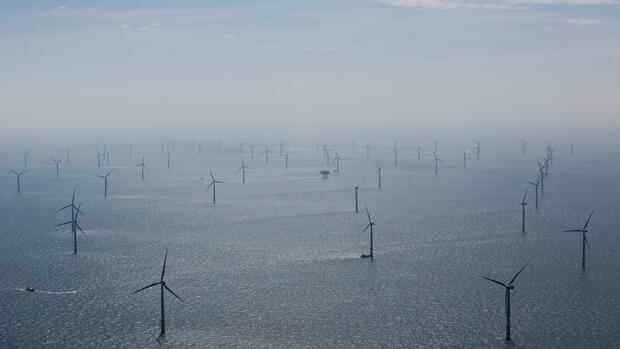The industry is convinced that the draft of the WindSeeG has some weaknesses.
(Photo: REUTERS)
Berlin The traffic light coalition attaches great importance to wind power on the high seas in accelerating the energy transition. This is reflected in the coalition agreement: the expansion target for offshore wind power for 2030 is to be increased from 20 gigawatts (GW) to 30 GW. For classification: 7.8 GW are currently installed.
In order to achieve the goal, the federal cabinet wants to adopt the draft of the offshore wind energy law (WindSeeG) from the House of Economics Minister Robert Habeck (Greens) on Wednesday. From the point of view of the industry, the draft has some shortcomings that can lead to significant cost increases.
“We are worried that the tendering criteria will not work and will drive up the electricity price further,” says Stefan Thimm, Managing Director of the Federal Association of Offshore Wind Farm Operators (BWO).
Criticism from the industry is sparked by the plan to introduce a tender with a “bid component” for around half of the available space. This means that wind farm operators have to offer an “entrance fee” for being allowed to use an area at sea for electricity production. Whoever offers the highest price wins the bid.
Top jobs of the day
Find the best jobs now and
be notified by email.
The industry doubts the usefulness of such solutions. “We advocate not overstretching the willingness to pay for the bid,” warns Thimm. He refers to the case of Denmark, where 380 million euros were recently paid for the installation of one gigawatt.
The previous government already had such plans
“As a result, only the really big players can bid. For medium-sized companies in the energy sector, such sums are unaffordable,” says Thimm. Even many energy companies are being pushed to the limits of their financial capacity. “Ultimately, the electricity customer has to pay for all of this, because the companies not only have to recoup the costs for the wind turbines, but also the payment for the surcharge and the resulting increase in capital costs,” he says.
>> Read here: Why the wind power industry is withdrawing more and more from Europe
Thimm calls the bid component “stupid money” that is urgently needed elsewhere to increase security of supply and reduce supply risks. He calls for the bid component to be removed or limited.
The topic is not new. The previous government had already attempted to incorporate a bid component into the WindSeeG in 2020. The attempt failed due to resistance from the SPD and the Greens. In the industry, one is therefore surprised that a government with the significant participation of these two parties is making a new attempt to introduce the “entrance fee”.
>> Read here: Wind power from the North Sea, solar power from Spain – this is what Europe’s energy grids are like
The WindSeeG is part of the so-called “Easter Package”, which is to be passed on Wednesday. The package contains a number of projects designed to help speed up the expansion of renewable energies.
From the perspective of the offshore industry, the law has other pitfalls. For example, the BWO mentions the planned regulation to make the recycling quota for the rotor blades an award criterion. “Companies should provide information on how well the rotor blades can be recycled after dismantling – 37 years later. But nobody knows what technologies will then be available,” says Thimm. The 37 years result from a plant life of 30 years and a lead time from the award to completion of a further seven years.
The award criterion of the “most environmentally compatible foundation” also raises questions in the industry. The industry criticizes that no statements can be made about areas that have not been pre-examined. “Companies can only guess,” says Thimm.
More: Habeck and Lemke present key points for environmentally friendly wind power expansion.
